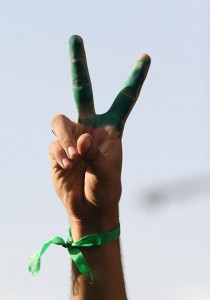Iran Analysis: The "Now What" Moment (Farhi)
 Thursday, February 18, 2010 at 12:15
Thursday, February 18, 2010 at 12:15  Farideh Farhi writes for Inter Press Service:
Farideh Farhi writes for Inter Press Service:After eight tumultuous months, during which attention from all sides of Iran's political spectrum as well as anxious watchers around the world focused on a series of street clashes between protesters and the government's security forces, an eerie calm has taken hold in Iran.
The government's ability to control the aesthetics of street demonstrations on the occasion of the revolution's 31st anniversary on Feb. 11 has once again confirmed the robust nature of the Iranian state, which used its long experience with government-sponsored demonstrations to stage what it now claims was a decisive "show of unity" involving "50 million" people "to bury the corpse of sedition."
Iran: Another Rethink on Green Opposition (Ansari)
Latest on Iran (18 February): Watching on Many Fronts
This is a significant development insofar as it disabuses policymakers outside Iran, as well as a large number of Iranian exiles, of the fantasy of the impending doom of the Islamic Republic or the belief that substantive change in Iran can or will come quickly.
Yet, despite the government's proclaimed unity, nothing that happened on Feb. 11 suggests that the fundamental cleavages that have rocked Iran in the past few months have been overcome. Indeed, the only message of Feb. 11 is that, by spending a tremendous amount of resources and energy on security, arrests and mobilisation, the government can control the crowds.
Reports from a variety of participants suggest that many supporters of the opposition that has come to be known as the Green Movement did come out, but simply did not know what to do or how to make their presence felt in the streets. In addition, the regime's deployment of abundant numbers of security personnel ensured that anyone who did make his or her presence known was swiftly pulled out of the crowd, led away or arrested.
In other words, the security and intelligence organisations managed the stage so effectively that, despite the attendance of more than 400 foreign journalists and photographers, the presence of the government's supporters
dominated the coverage. This was achieved not only by the massive security presence, but also by limiting the movement of foreign journalists; restricting - and, at times, even preventing - access to the Internet and cellular communications networks; the pre-emptive arrest of suspected protest organisers; and preventing the participation of recognised Green leaders, notably Mir Hussein Mousavi and his spouse Zahra Rahnavard, Mehdi Karroubi and former president Mohammad Khatami, through intimidation and pre-meditated mob attacks. The fact that, unlike the protests during Ashura on Dec. 27, no one was killed last week added to the impressiveness of the government's efficiency in controlling the streets, a striking contrast to the eight months that followed the disputed June elections.
But managing the stage and controlling the crowds on any given day are not the same as actually resolving the problems and grievances that have repeatedly brought protesters into the streets. Unless some of these are addressed, the Iranian state will remain on edge, vigilant, and engaged in a permanent crackdown that will effectively undermine the country's economic and regional ambitions.
The fact that some Green Movement activists may now be less inclined to use official holidays to mount their protests - or even be pushed underground --- will make dissent less predictable and thus significantly more difficult to control without the expenditure of even more state resources for the purposes of repression.
It is this dilemma that the Iranian leaders must address in the coming months. Even if it is accepted that the Green Movement is disheartened and the government "victorious," the country's multi-voiced and faction-ridden leadership cannot simply walk away from the events of the past eight months and avoid the "what now" question.
The country, after all, remains the same as before Feb. 11. Iran's political system, with its bickering elites, remains as dysfunctional as ever. And President Mahmoud Ahmadinejad's administration is still perceived as incompetent even by many of its conservative backers at a time when the government faces the dual challenge of embarking upon what it calls the "economic surgery" of reforming the country's unwieldy subsidy system and thwarting growing foreign pressures to curb the country's nuclear programme.
To be sure, facing simultaneous economic and external challenges is nothing new for the Iranian leadership. During the Iran-Iraq War, the government did precisely that by relying on the post-revolutionary spirit of sacrifice and unity in the face of extreme adversity.
But, as pointed out by the conservative editor of Ayandenews, Fouad Sadeghi, the still-unaddressed internal divisions have turned Iran's dual challenge into a triple one, making overcoming the first two unlikely, if not impossible, without addressing the third.
It must be considered a sign of the raw nerve this conundrum struck that Sadeghi, whose brother was killed in the Iran-Iraq War and who was himself an active member of Basij militia while studying at the highly politicised Amir Kabir Technical University in the 1990s, was arrested on the very eve of the anniversary celebration, soon after publishing his commentary.
Read rest of article....

